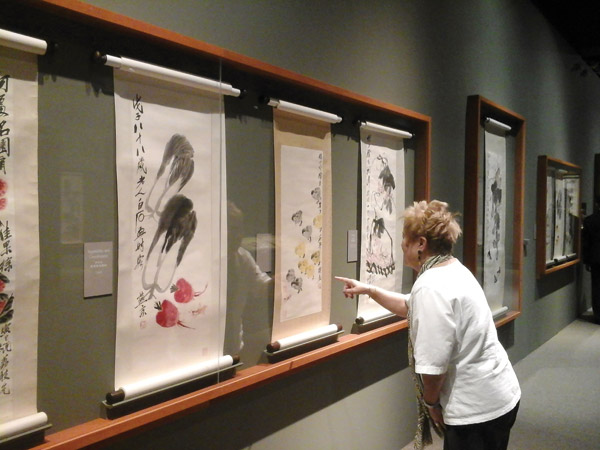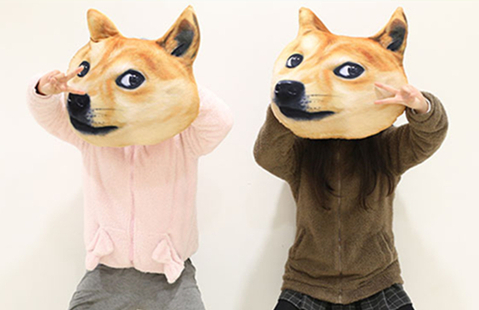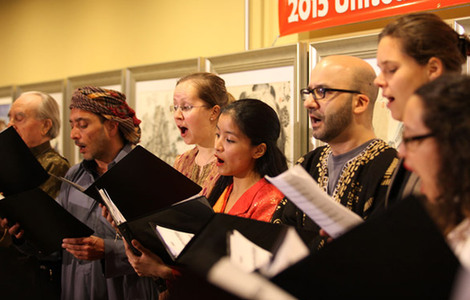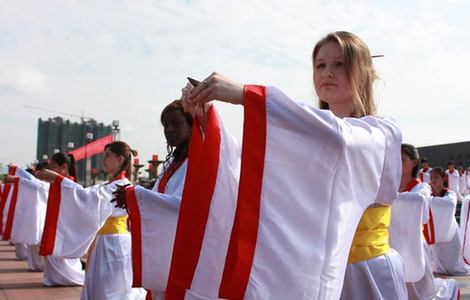Qi Baishi retrospective shown in California
Updated: 2015-04-22 11:44
By Lia Zhu in San Francisco(China Daily USA)
|
||||||||
 |
|
A visitor views the paintings of Qi Baishi during the four-month exhibition Qi Baishi: China's Modern Master, on display at Bowers Museum in Santa Ana, California, until July 11. Provided to China Daily |
US audiences have the chance to view the artwork of Qi Baishi, the Chinese artist who has outsold Pablo Picasso and Andy Warhol in the global art market.
An exhibition, Qi Baishi: China's Modern Master, is on display at Bowers Museum, in Santa Ana, California, until July 11.
Qi Baishi (1864-1957), born into a peasant family in Hunan province, became a carpenter at 14 and began studying art at 27. After traveling throughout China, he settled in Beijing in his late 50s and developed a unique style, boldly blending his mark as an individual with traditional Chinese painting methods.
More than 50 items of his art, including scroll paintings, calligraphies, seals and wood carvings, were selected from China's Hunan Provincial Museum, reflecting the artist's early career as a figure and landscape painter to the paintings from the zenith of his career that favored quick, expressionistic images of animals, flowers and food, according to Anne Shih, chairwoman of the board at Bowers Museum, who handpicked the artworks.
"This exhibition is aimed not only to pay tribute to this great artist, but also to help a larger American audience to learn about traditional Chinese culture through the masterpieces, and build a bridge between Chinese and the US cultural exchanges," Shih said.
"It is also a rare opportunity for the American audience, as it marks the first time that this collection has been exhibited in the United States," Shih told China Daily.
Due to a limitation of funds, this exhibition was made available to the Bowers Museum by an exchange. First Americans: Tribal Art of North America, which contains more than 100 American Indian artifacts from the Bowers collection, is on loan to the Hunan museum from March 27 to May 27.
"And because a new building is being constructed at the Hunan museum, the artworks are temporarily put away in a storehouse," she said. "When the new building is completed, the artist's works will be displayed there and never on loan again."
Among the most notable exhibits of Qi's at Bowers is a wood carving, which was created during the artist's early exploring period when he worked as a carpenter.
"It's a significant part of his artistic growth, and few collectors have such kind of works," said Shih.
The audience's positive feedback has exceeded the organizer's expectations, according to Ching Chausse, a guide at the Bowers Museum.
Maybe it's because of his humble beginnings, the subjects of Qi Baishi's paintings include almost everything commonly found in daily life, such as birds, insects, vegetables and toys, relatable to all people, she said.
"The American audience is most fascinated by his integration of traditional Chinese painting with impressionistic style," said Chausse, who received training for the exhibition before it opened on April 11.
"He upheld a theory that 'paintings must be something between likeness and unlikeness'," she said. "That's why his paintings are enjoyed by the vulgar and admired by the refined as well."
In his later years, he painted shrimp and even mice and frogs, which the traditional painters would not depict. "It's a breakthrough from the traditional school," Chausse said.
Qi was compared to Auguste Rodin, publicly admired by Picasso, and who influenced the work of many artists, including Isamu Noguchi.
In 2011, Qi's 952 artworks tallied $445.1 million at auction, placing him second on Artprice's list of top five artists by annual auction revenue. Picasso ranked fourth at $311.6 million.
liazhu@chinadailyusa.com

 Chinese real estate deals in US topical forum
Chinese real estate deals in US topical forum
 Weird stuff you can buy on Taobao
Weird stuff you can buy on Taobao
 Top 5 wealthiest women in world's tech sector
Top 5 wealthiest women in world's tech sector
 Outsiders challenge traditional smartphone makers
Outsiders challenge traditional smartphone makers
 Helicopter replica on the road
Helicopter replica on the road
 Singing Chinese language's praises
Singing Chinese language's praises
 Foreign girls join in ancient Chinese coming-of-age ritual
Foreign girls join in ancient Chinese coming-of-age ritual
 Shanghai auto show kicks off
Shanghai auto show kicks off
Most Viewed
Editor's Picks

|

|

|

|

|

|
Today's Top News
Real estate investors may switch focus: panel
China sustains US cities: Bloomberg
Obama submits nuclear energy cooperation deal with China
US urges Japan to handle wartime history in constructive way
Mexico bans poultry, egg imports from bird flu-hit Iowa
Bloomberg: Chinese investment sustains US cities
China, Pakistan elevate ties, commit to long-lasting friendship
'Belt-Road' to exchange goodwill with economic coopertation
US Weekly

|

|






